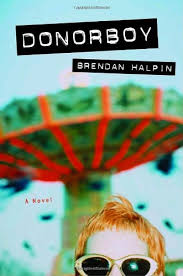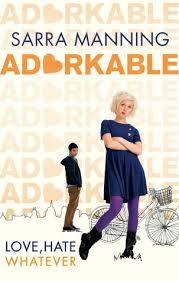Introduction
by Jeanne Henry, Hofstra University & Gina Sipley, Nassau Community College & Hofstra University
 The best YA authors have a nose for what’s next, and so it was no surprise to me in 2005 when I came across Lauren Myracle’s TTYL— a book told entirely in the teen discourse of the day, AIM (AOL Instant Messenger). In the decade since TTYL made its appearance, other YA authors have begun to depict the lives of teens who move through the digital world and for whom coming of age often happens online. In acknowledgment of YA literature’s first digital decade, I decided to devote a topical seminar I teach in the Literacy Studies Doctoral Program at Hofstra University to the study of 10 YA novels that feature extensive online activity. For the month of July, I, along with my co-editor Gina Sipley, will share with you some of the thinking and writing of a selection of these doctoral students, with the reminder that the entire class contributed, through discussion and debate—to the individual insights and conclusions shared here.
The best YA authors have a nose for what’s next, and so it was no surprise to me in 2005 when I came across Lauren Myracle’s TTYL— a book told entirely in the teen discourse of the day, AIM (AOL Instant Messenger). In the decade since TTYL made its appearance, other YA authors have begun to depict the lives of teens who move through the digital world and for whom coming of age often happens online. In acknowledgment of YA literature’s first digital decade, I decided to devote a topical seminar I teach in the Literacy Studies Doctoral Program at Hofstra University to the study of 10 YA novels that feature extensive online activity. For the month of July, I, along with my co-editor Gina Sipley, will share with you some of the thinking and writing of a selection of these doctoral students, with the reminder that the entire class contributed, through discussion and debate—to the individual insights and conclusions shared here.
While the books we read were not to everyone’s taste, we did conclude that, when read against the context of Danah Boyd’s (2014) It’s Complicated: The Social Lives of Networked Teens and Jane McGonigal’s (2011) Reality is Broken: Why Games Make Us Better and How They Can Change the World, these YA authors actually seem to understand the digital lives of today’s teens far better than do their parents, their teachers, the corporations that market to them, and the press. The books included in the class were (an asterisk indicates the ones to be discussed in the course of our blog entries):
Boyd, D. (2014). It’s complicated: The social lives of networked teens. New Haven, CT: Yale University Press.*
Brezenoff, S. (2014). Guy in real life. New York: Balzer + Bray.
Cline, E. (2011). Ready player one. New York: Crown.*
Doctorow, C. (2008). Little brother. New York: Tor Teen.*
Doctorow, C. (2010). For the win. New York: Tor Teen.*
Doctorow, C. and Wang, J. (2014). In real life. New York: First Second Books.*
Halpin, B. (2004). Donorboy. New York: Villard.*
Manning, S. (2013). Adorkable. London: Little, Brown Book Group.*
McGonigal, J. (2011). Reality is broken: Why games make us better and how they can change the world. New York: The Penguin Press HC.*
Myracle, L. (2005). TTYL. New York: Amulet Books.
Rowell, R. (2013). Fangirl. New York: St. Martin’s Griffin.
Vail, R. (2014). Unfriended. New York: Viking Books for Young Readers.
Additionally, we identified and wrote about this books with networked content:
Berk, J. (2010). The dark days of Hamburger Halpin. New York: Knopf Books for Young Readers.*
Our writing is more focused on teens and trends as reflected in the novels, but Molly Wetta’s superb August 20, 2014 ALA blog, “Coming of Age Online: Social Media in YA Literature,” provides thorough summaries of many of these, and other, YA titles that involve digitally-adapting teens. We invite you to comment, to share your insights and observations, or just suggest more to read!
Note from the Authors:
With great appreciation to Stephanie Eberhard-Holgerson, Petrice Grimaldi, Jinsook Jung, James Kennedy, Andrea Lachar, Chris Sclafani, Shelita Watkiss, Beth Winter, Beverly Wolcott, and QianHe “Grace” Zhao, and Andrea García.
The Digital Tongue
by Jeanne Henry, Hofstra University & Lorraine Radice, Long Beach Middle School, Long Beach, NY, & Hofstra University
 You’ve probably heard it too. “Kids today don’t talk to each other any more! They just stare at screens!” But of course they are talking, communicating, using their words, or at least the consonants, to chat, gossip, laugh, or play a word game. As early adopters of technology, teens were perhaps the first to understand that there are simply times when it’s just a lot more comfortable to text than to speak face-to-face. “The digital tongue,” a term coined by Lorraine Radice, refers to when the movement of the fingers replaces the movement of the lips, a practice used in several YA novels in which teens negotiate difficult relationships through texting, tweeting, emailing, and journaling. In this first July blog entry, we’ll discuss Brendan Halpin’s recently republished Donorboy (2005) and Sarra Manning’s Adorkable (2013) to explore the power of the digital tongue, when honestly employed, to assist in the development of otherwise unlikely relationships.
You’ve probably heard it too. “Kids today don’t talk to each other any more! They just stare at screens!” But of course they are talking, communicating, using their words, or at least the consonants, to chat, gossip, laugh, or play a word game. As early adopters of technology, teens were perhaps the first to understand that there are simply times when it’s just a lot more comfortable to text than to speak face-to-face. “The digital tongue,” a term coined by Lorraine Radice, refers to when the movement of the fingers replaces the movement of the lips, a practice used in several YA novels in which teens negotiate difficult relationships through texting, tweeting, emailing, and journaling. In this first July blog entry, we’ll discuss Brendan Halpin’s recently republished Donorboy (2005) and Sarra Manning’s Adorkable (2013) to explore the power of the digital tongue, when honestly employed, to assist in the development of otherwise unlikely relationships.
 Donorboy (2005) involves what has to be one of the all-time most awkward and improbable of YA relationships: that of grieving teen, Rosalind, who has just lost her two moms, and Sean, the source of her mothers’ donor sperm. We never learn precisely why Rosalind’s moms asked Sean to be their donor, other than Sean’s own guess that it was because his medical history was clean and he was too young to want to be involved in the child’s life, but when Mom and Mommy are both killed in a car accident, Sean decides to assert his parental rights, much to the dismay of Rosalind, and just about everyone else. With equal parts selfish dissatisfaction with the direction of his own life, and sincere concern for Rosalind, Sean sets out to become a variation on the “velveteen father” (Green, 1999). Rosalind responds by refusing to speak to him.
Donorboy (2005) involves what has to be one of the all-time most awkward and improbable of YA relationships: that of grieving teen, Rosalind, who has just lost her two moms, and Sean, the source of her mothers’ donor sperm. We never learn precisely why Rosalind’s moms asked Sean to be their donor, other than Sean’s own guess that it was because his medical history was clean and he was too young to want to be involved in the child’s life, but when Mom and Mommy are both killed in a car accident, Sean decides to assert his parental rights, much to the dismay of Rosalind, and just about everyone else. With equal parts selfish dissatisfaction with the direction of his own life, and sincere concern for Rosalind, Sean sets out to become a variation on the “velveteen father” (Green, 1999). Rosalind responds by refusing to speak to him.
Eventually, driven by hunger, Rosalind breaks down and writes Sean a note (after rehearsing more insulting drafts): “Sean. I am a vegetarian. Please buy food. There is never any food here” (Halpin, 2005, para. 28). Sean responds, “Rosalind—bought food. Will microwave one organic burrito of your choice in exchange for five words. Think it over” (Halpin, 2005, para. 30). This digital conversation marks the first exchange in a long, hard-won thaw between Rosalind and Sean that can only occur in messaging because both of them need time to compose their thoughts. Rosalind needs a moment to dial back her hostility and Sean needs to cushion himself from the rejection he risks every time he reaches out to Rosalind. This challenging relationship, which can only be repaired from a safe distance, suggests that the digital tongue is anything but cowardly.
 In Sarra Manning’s Adorkable (2013), heroine Jeane Smith’s first words to “It Boy” Michael Lee are “Go away.” At school, these six-formers are at the opposite extremes. Michael has it all: looks, grades, sports and friends. Jeane is a surly loner and thrift store fashionista who, at least at first glance, frightens the other kiddies. Is there any way other than texting, or tweeting or posting that these two could ever get through to each other?
In Sarra Manning’s Adorkable (2013), heroine Jeane Smith’s first words to “It Boy” Michael Lee are “Go away.” At school, these six-formers are at the opposite extremes. Michael has it all: looks, grades, sports and friends. Jeane is a surly loner and thrift store fashionista who, at least at first glance, frightens the other kiddies. Is there any way other than texting, or tweeting or posting that these two could ever get through to each other?
Without quite knowing why, Michael goes online to see what more he can learn about this loathsome Jeane Smith. And he finds that, online, Jeane is pop star royalty. Her blog, Adorkable, has over half a million followers, is also a “lifestyle brand and trend-spotting agency” (Manning, 2013, p.30). Michael thinks Jeane’s blog is “bollocks” (p. 31), but since she happens to be online while he’s lurking and asks the blogosphere how they feel about Parma violets (a candy), Michael jumps in with a response before, as he says, he can think of all the good reasons not to and, chemistry ensues.
While Adorkable is epistolary in its integration of technology, the tech tools themselves take a back seat to the plot of this improbable love story. Social networking provides Jeane an outlet in which she can be the witty, talented, keen and strong-minded young woman she is, without apology or compromise. Her digital voice, silent as it is, roars. And as for Michael, the boy who had to stick his “hand up and ask permission to go to the loo” (Manning, 2013, pp. 31-32), masking his identity online (for a little too long, as it turns out) gives him a chance to get past Jeane’s in-your-face approach to those who don’t mind coloring between the lines.
References
Halpin, B. (2015). Donorboy [Kindle version]. Retrieved from amazon.com.
Green, J. (1999). The velveteen father (1st ed.). New York: Villard.
Manning. S. (2013). Adorkable. London: Little, Brown Group.
Journey through Worlds of Words during our open reading hours: Monday-Friday, 9 a.m. to 5 p.m. and Saturday, 9 a.m. to 1 p.m. To view our complete offerings of WOW Currents, please visit archival stream.
- Themes: Gina Sipley, Jeanne Henry, Larraine Radice
- Descriptors: Books & Resources, WOW Currents
